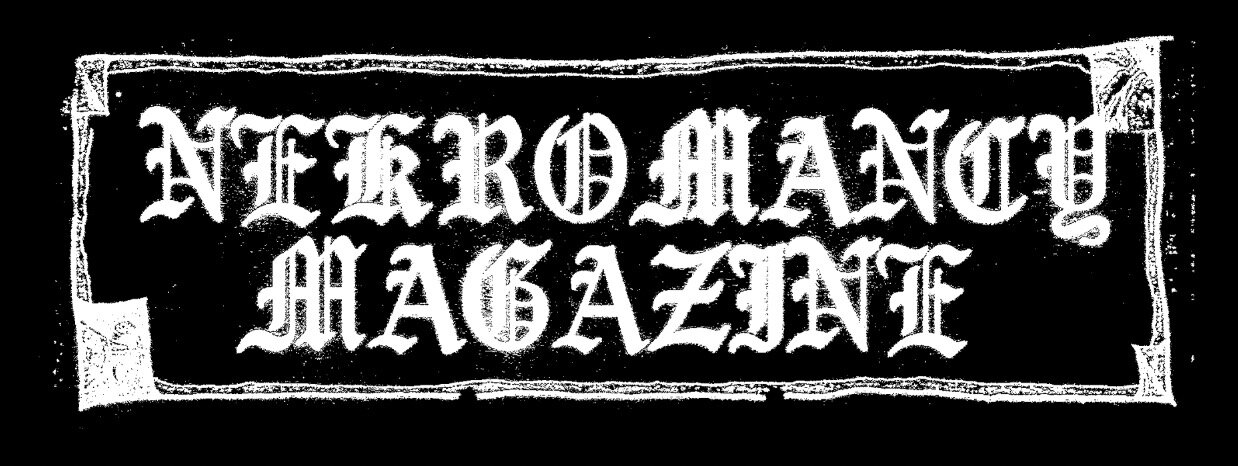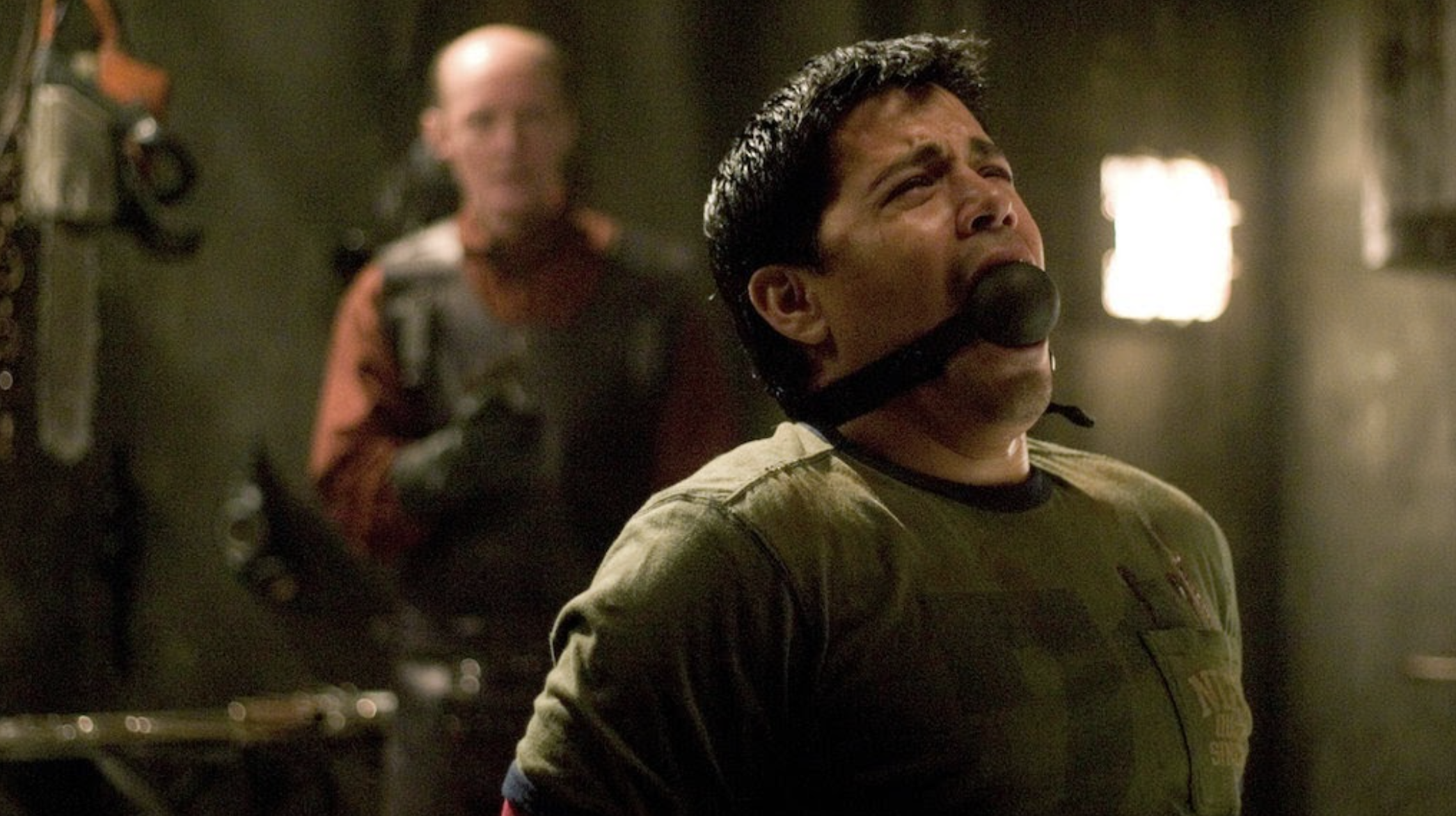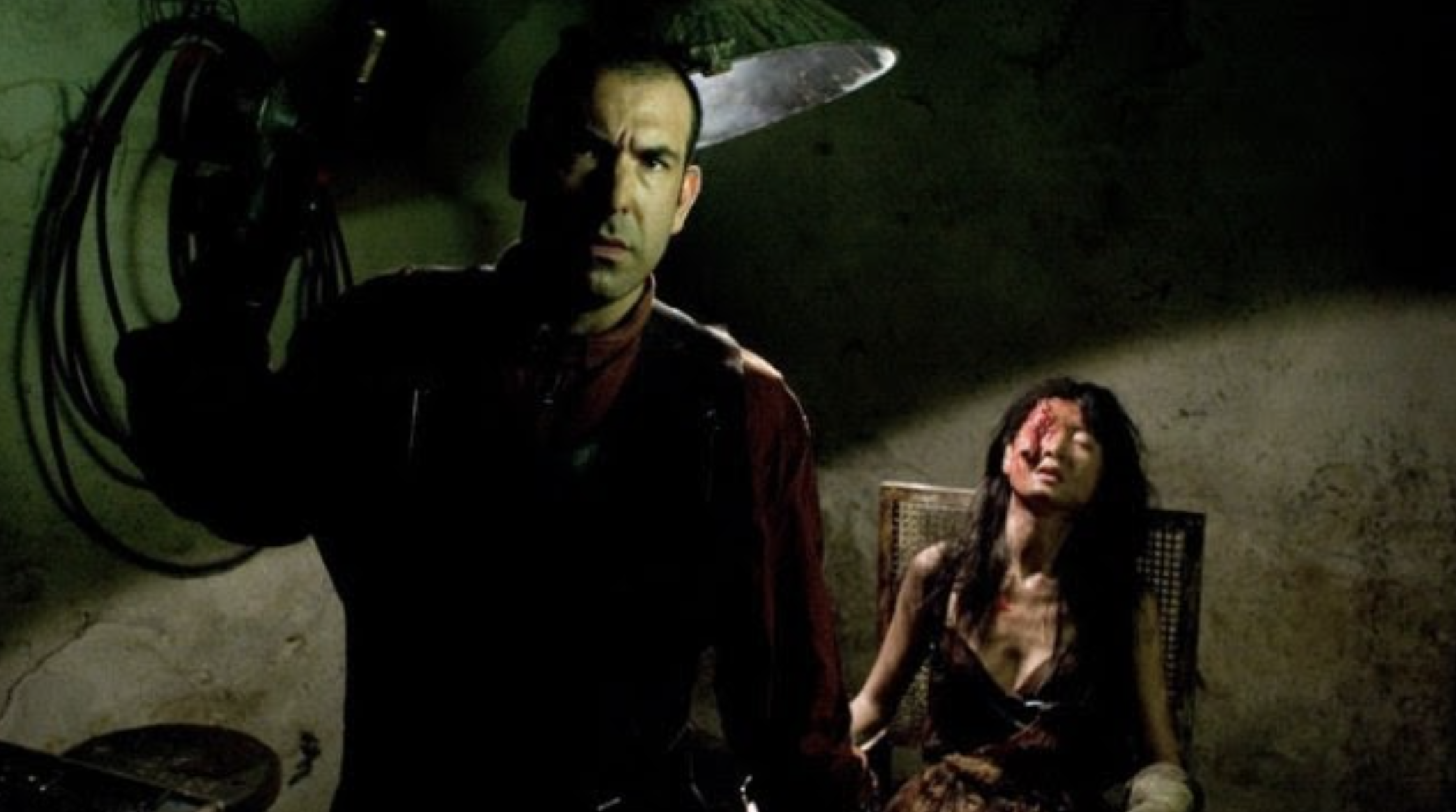Foul Play and Fetishisation: Quentin Tarantino’s Squeamish Voyeurism in Hostel and Exploitation-Core
April 23, 2021 ● Emma Doyle
Jay Hernandez in Hostel, 2005. Lionsgate Films
Quentin Tarantino has, for the last twenty-nine years, been an archetypal household name for embryonic film bros and dedicated aficionados alike. His directorial debut Reservoir Dogs (1992), alongside his iconic screenplay for scuzzy crime favourite True Romance (1993) both secured an experience of widespread mainstream success before the age of thirty. Not bad for a Knoxville boy brought up by an (often) single mother on the mean streets of Los Angeles. Crime movies, perhaps for this reason, seem to just make sense when it comes to analysing Tarantino’s ensuing output from this baptism of fire. Dabbling in exploitation-core, as illustrated with Hostel (2005) and Hostel II (2007), maybe less so. This opinion doesn’t stem from any questions raised over whether Tarantino is capable of constructing sharp dialogue and largely gratifying visuals, but rather from questions as to why he would choose to do this in the first instance. In the initial two Hostel instalments, of which Tarantino acted as executive producer, casual racism, cultural profiling and the use of economically challenged figures as bait is thinly veiled by a redwash of latex gore - seemingly in the hopes that this calibre of stunt would distract the audience from such a mortifying admission.
When examining the motivating factors for such flippant categorisation, the argument shows itself to be one hundred and one shades of grey as opposed to distinct black and white. Tarantino’s obtuse fetishisation of the working class, when delving into his personal origin story, can be seen either as some form of enthusiastic self-flagellation or vainglorious masochism. It is for this reason that my task of extricating the specific impetus which fueled the creation of the Hostel films is made all the more curious, as well as somewhat perplexing.
Jay Hernandez in Hostel Part II, 2007. Lionsgate Films.
If we are to embark on this descent into the territory of imprudent, ill-phrased cultural discourses, there is no better place to start than at the beginning.
Within the first ten minutes of Hostel, I was able to count at least a hat trick of rape jokes and the implication that all western European women will happily open their legs on demand if lunged at from across a pre-smoking-ban dancefloor. That’s just the American Dream, baby. And after fifteen minutes, we’re introduced to The Dutch Businessman (Jan Vlasák), a relatively affable character until he begins eating slices of lunch meat with his bare hands and makes an unwarranted homoerotic advance towards one of the film’s three transatlantic protagonists, which they, of course, greet with exaggerated bigotry and small-mindedness. I’m not personally able to speak on behalf of the entire population of the Netherlands to confirm or deny whether there is a disproportionate number of their citizens who behave in the same disconcerting manner. However, since Hostel is, as far as the world is aware, a piece of fully-constructed fiction, the conclusion can be drawn that this may simply be a throwaway, intolerant Americanism. Despite director Eli Roth’s protestations that this was “not a geographical work, but aims to show Americans’ ignorance of the world around them”, it becomes a chore not to tar the man with the same accusatory brush. We’re practically set up for a paint-by-numbers. And as far as Tarantino’s involvement reads, greenlighting so many bizarre scriptwriting choices translates as, if not perniciousness, at least midweight stupidity. Tomáš Galbavý, a member of the Slovak Democratic and Christian Union-Democratic Party, went as far as to say that “all Slovaks should feel offended” by Tarantino and Roth’s portrayal of Czechoslovakia. If rendered inseparable from an underdeveloped wilderness in which a lack of economic security has bred lawlessness in the form of daytime prostitution and a homicidal bias for the sake of a stick of chewing gum, I too would likely jump to the defence of my fellow occupants.
Rick Hoffman and Keiko Seiko in Hostel, 2005. Lionsgate Films.
The good people of Slovakia are, through the executive lens of Tarantino, thus elevated in the public gaze as a circus attraction - gawked at and ridiculed as a result of this cheap cinematic misrepresentation. But now to the crux of this essay. More concerning than unhesitating dismissal is perhaps the inordinate level of voyeuristic brutality directed towards young, female characters both in Hostel and Hostel II. Despite there being a distinct lack of foot-focused content as has come to be expected of Tarantino and his rumoured fetish, the deaths and near-fatalities experienced by these characters in direct comparison to their male counterparts are drawn out and dramatically hypersexual. In Hostel, the character of Yuki, portrayed by Keiko Seiko, is subjected to what I can only assume is an hours-long torture session at the hands of a paying client, who happily brulées her right eye with a blow torch to the point of it resembling the Czech Republic’s worst-tasting custard donut. When Yuki subsequently throws herself in front of a passing train after catching sight of her reflection raises questions over Tarantino’s personal comprehension of the fact that Asian women, like most others, have values that extend beyond an obsession with superficial aesthetics (shock! Horror!).
A trap in the same vein experiences a renaissance in Hostel II, when Bijou Philips’ Whitney is intricately laced into a particularly far-fetched burlesque ensemble, gagged, and then scalped to the point of extreme trauma but a not-quite-death. In Hostel II, similarly, although fatally, Heather Matarazzo’s Lorna is hog-tied and strung up by the ankles, having her throat cut and blood drained in a Bathory-esque display, staged expertly by Roth and Tarantino in order to drag the entire sequence out as long as possible for what I can only assume is maximum effect. This stark juxtaposition between these and the relatively quick, clean deaths of the few unlucky male characters only goes further to solidify my sentiment that Quentin Tarantino’s executive ruling is, viewing the evidence, rooted in misogyny, with his disposable female cast providing the entertainment in the show. The predator’s inert, defenceless prey.
Keiko Seiko in Hostel, 2005. Lionsgate Films.
I am once again given little choice but to reduce yet another cultural and gender-based debate down to the principle that, In Hostel and Hostel II, a greater measure of central importance is placed upon the experiences of the films’ affluent male characters over those that present as female, or those whose ethnicities are anything but white American. The pillars of sexism and assumed superiority are, unfortunately, still very much intact, and are unlikely to experience vital modernisation any time soon. Although Tarantino is but one spinning cog in the infernally male-focused cinematic mechanism, his influence has been instrumental in steering the narrative of Hostel, in a way that is undeniably more obvious than many of his films, towards extreme machismo. Although perhaps not intentionally outright offensive, it’s no doubt that brawn over brains fails to capture the hearts of the masses the way it used to. We are fed the notion that ‘boys will be boys’, but Tarantino is in his own disaffected league, with the creation of films that effortlessly alienate an audience larger than the one they attract. My final piece of advice? Stick to the crime movies. Upon rewatching, these ones are safer kept locked up.
Emma Doyle ● Writer
Instagram: @emma.j.doyle @slowrom_ance
I am a Manchester-based writer and creative who has made a hobby out of imparting criticism on almost everything possible and complaining about everything which isn’t. I blame my obsession with the macabre and morbid entirely on a premature reading of The Pit and The Pendulum, although ask me unrehearsed and I’ll most likely change my answer.




